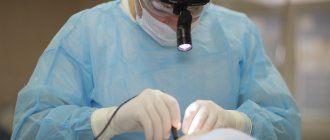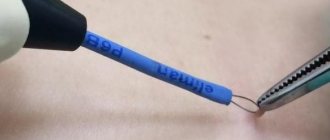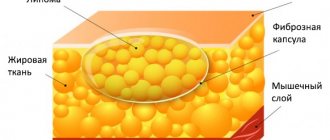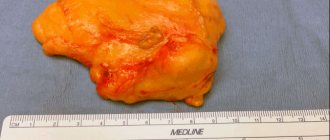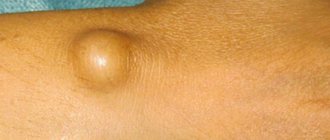Surgeon
Bohyan
Tigran Surenovich
Experience 37 years
Surgeon of the highest category, Doctor of Medical Sciences, member of the International Association of Surgeons, Gastroenterologists and Oncologists
Make an appointment
Lipoma (fat) is a benign formation in the form of small nodules, the appearance of which is associated with the accumulation and compaction of excess adipose tissue. The size of the lipoma may increase or remain stable. When exposed to unfavorable factors, pockets of pathogenic microflora can form inside the wen, which makes it a source of other serious diseases of internal organs. The unaesthetic appearance of formations protruding on the surface of the skin is also important. Therefore, in most cases, a decision is made to remove the tumor and its subsequent histological examination to clarify the nature of the wen - benign or malignant.
The area of localization of lipoma is the back, chest, face, limbs, mammary glands, structure of internal organs. The formation can be detected accidentally during diagnostic procedures or during palpation. The edges of the lipoma are dense and clear, the formation is mobile, and its palpation is painless. It is more difficult to detect a lipoma in the tissues of internal organs. However, it is precisely such cases that are recognized as the most dangerous, threatening disruptions in the functioning of the affected tissue area.
Classification
Depending on the internal structure there are:
- Myolipomas are formations from muscle cells.
- Angiolipomas are lipomas with the inclusion of blood vessels.
- Myxolipomas are tumors containing mucus.
- Fibrolipomas are formations containing connective tissue.
It is possible to accurately determine the nature of the formation only after a thorough diagnosis. It should not be postponed for the foreseeable future, especially if the lipoma quickly increases in size and causes discomfort.
When to go to the doctor for help
After examining the lipoma, doctors themselves may delay prescribing treatment. But if symptoms such as:
- sharp and rapid growth of wen
- change in skin color and lipoma shape
- the appearance of redness or inflammation around the lipoma itself
- when squeezing or pressing, pain occurs
- release of any liquid (substance) from the wen
- appearance of a foreign pungent odor
If any of the above symptoms appear, it is best to contact a medical institution, where the doctor will prescribe all the necessary studies and tests to clarify the diagnosis. Most often, such tests are prescribed to exclude the appearance of a malignant tumor.
Useful information about visiting a surgeon at the clinic:
- How to prepare for a surgeon's appointment
- What diseases does the surgeon treat?
- Calling a surgeon to your home
- Surgical care in the clinic
- Surgical care at home
- What symptoms should you contact a surgeon for?
- Treatment of surgical diseases
- Treatment of intestinal pathologies
- Treatment of skin surgical pathologies
- Treatment of bedsores and necrosis
- Treatment of parasitic diseases
- Treatment of inflammatory processes of soft tissues
- Treatment of diseases of the musculoskeletal system
- Diagnosis of surgical diseases
Causes of lipoma
The general pattern of the appearance of wen is the accumulation of fat cells due to a violation of fat metabolism in the body. If measures to treat the problem are not taken in a timely manner, the formation quickly grows, pinching nearby muscles and blood vessels. Among the causes of lipoma that influence the unfavorable course of the pathology, it is worth noting:
- Hormonal disorders, a period of hormonal changes in the body.
- Metabolic failures.
- Disturbances in the diet with a predominance of food of animal origin.
- Diseases of the kidneys and liver, pancreas and thyroid gland.
- Bad habits.
- Diabetes.
- Genetic predisposition.
Also, the formation of excess adipose tissue is affected by physical inactivity, a sedentary lifestyle and refusal of full-fledged physical activity.
Symptoms
The main localization of wen is the place of deposition of adipose tissue. At first it is a soft compaction, which gradually increases in size. The only symptom of a lipoma is the formation of a noticeable tubercle with a movable structure, which can be felt when pressed. There is no pain when palpating the lipoma on the back or arms.
If the wen is localized in the structure or on the surface of internal organs, disturbances in their functioning may indicate pathology. The disease is also accompanied by characteristic symptoms:
- a lipoma in the esophagus causes coughing, nausea and vomiting;
- formations on the bronchi and trachea cause a constant dry cough of a paroxysmal nature;
- lipoma on tendons and cartilage limits their mobility and causes pain;
- a lump in the mammary gland gives pain;
- fatty deposits in the kidneys provoke colic, lower back pain, and increased blood pressure;
- a lipoma in the head causes dizziness and headaches;
- a formation in the neck makes it difficult to swallow food and also causes hoarseness;
- A lipoma in the heart area causes arrhythmia and heart failure.
Are you experiencing lipoma symptoms?
Only a doctor can accurately diagnose the disease. Don't delay your consultation - call
What is atheroma?
Atheroma is a cyst of the sebaceous gland that occurs when its duct is blocked. Sebum cannot come out and accumulates inside, it stretches the gland, and it turns into a cystic cavity. This can happen for a variety of reasons, often due to trauma to the skin.
Atheromas most often occur where there is a lot of hair and sebaceous glands: atheromas on the scalp, face, neck, back, genitals.
In its manifestations, atheroma resembles a lipoma: it is also a “bump” that is located under the skin, does not cause pain and easily moves when pressed. But there is one characteristic sign: usually there is a hole in the skin in the area of atheroma through which contents with an unpleasant odor are periodically released. Inside the atheroma there is a substance that resembles cottage cheese or paste in consistency.
Atheroma is a benign formation. It's not cancer. The only thing that is dangerous about it is the possibility of suppuration. An infected and inflamed “bump” swells, turns red, and becomes painful. Sometimes it opens and pus comes out along with fat.
Atheromas can degenerate into malignant tumors, but this happens very rarely.
Methods for diagnosing lipomas
The long period of latent progression greatly complicates the diagnosis of soft tissue lipoma in the early stages of development. More often, pathology is detected when the wen reaches a size of 1.5-2 cm and is easily palpable under the skin. To carry out differentiated diagnostics and confirm the benign nature of the formation, you can:
- Blood tests to exclude viral or bacterial infections, as well as the absence of an inflammatory process.
- X-ray of the chest, limbs or abdomen. Allows you to detect a formation, clarify its location, calculate its size and assess the condition of surrounding tissues.
- Ultrasonography. It is used as an additional diagnostic method when the presence of a lipoma is confirmed by other examination methods.
- Computed and magnetic resonance imaging. Effective methods to determine the location and size of the lipoma, as well as confirm its benign nature.
- A biopsy of wen tissue to analyze it for the risk of cells degenerating into a malignant structure.
If the patient has other diseases of the internal organs, the diagnosis of lipoma is carried out taking into account their characteristics, and deciphering the results suggests the mutual influence of pathologies, making it possible to more accurately determine the cause of the appearance of the wen.
Preparatory stage
To make sure that the manipulation can be carried out, the doctor must first conduct a diagnostic examination. This applies not only to palpation and visual assessment.
The specialist examines the medical history to determine the optimal technique for getting rid of the benign tumor. A number of diagnostic measures at the preparatory stage can help determine this. The appointment begins with the doctor determining the exact shape, structure and softness of the wen, recording the collected information from the medical card.
Next, the victim is sent to submit:
- blood analysis;
- biopsy;
- ultrasonography;
- MRI;
- CT;
- histology.
Classic ultrasound helps determine how quickly the problem area is enlarging and whether it is occurring at all. Also, a detailed, unique image will indicate the overall scale of the spread of the disease through adipose tissue.
In case of controversial situations, it would be useful to use images obtained using a magnetic resonance imaging scanner. Due to the obtained visualization through MRI or computed tomography, it is possible to determine whether the lipoma is in a life-threatening area.
The biopsy is designed to reveal the nature of the formation before surgery, and histology tells us whether there were metastases after surgery.
Regardless of how extensive the lesion turns out to be, it can only be gotten rid of in an inpatient hospital department, when the test results are already in hand.
Treatment
If small lipomas are detected in a patient, a wait-and-see approach is chosen, which involves ultrasound monitoring several times a year. However, there are often cases when the doctor decides in favor of surgical intervention. Surgery is necessary if:
- The tumor grows rapidly, engulfing neighboring tissues and blood vessels.
- The lipoma rises above the surface of the skin, giving an unaesthetic cosmetic effect.
- The development of a wen gives persistent pain.
- Due to the growth of adipose tissue, the functioning of internal organs and the circulatory system is disrupted.
Removing or destroying a lipoma on the neck or back is possible in the following ways:
- Endoscopic method. It involves removing the tumor along with the capsule through a small incision in the skin.
- Liposuction is the extraction of adipose tissue by softening it and stretching it through a thin needle. Does not leave scars and does not injure the skin.
- Excision of a lipoma is the removal of a wen during a classic surgical intervention.
The optimal method is selected taking into account the general condition of the patient and the size of the lipoma.
Radio wave method for removing wen
A bloodless and painless method to remove subcutaneous lipoma using high frequency radio waves. It has advantages over laser lipoma removal in terms of less trauma and postoperative complications. The operation is performed under local anesthesia and is therefore completely painless. After the operation, the patient can go home immediately.
A relative disadvantage can be considered the fact that each wen is removed through a separate incision, as with the classical method. But unlike conventional excision, there is less traumatic effect on the tissue, which eliminates infection, reduces bleeding and the risks of postoperative hematomas, and most importantly, reduces the likelihood of the formation of rough scars and scars. The cosmetic effect is better than with classical excision. Postoperative scars after complete healing are almost invisible .
But in each specific case, predicting the reaction of the skin to any mechanical impact - an incision, be it with a scalpel, or a laser or a radio wave, is quite difficult. Even with the best and most modern suture material and threads that can dissolve on their own, the skin can react unpredictably with the formation of a hypertrophic scar up to a keloid.
But medicine does not stand still. What can modern surgery offer?
A technique that is much more effective than laser and radio waves.
Diagnosis and treatment of lipoma at the JSC Meditsina clinic in Moscow
The clinic of JSC "Medicine" in the Central Administrative District of Moscow is ready to offer professional assistance to patients with suspected single or multiple cases of lipoma development. The center’s specialists have high-quality equipment and extensive practical experience in using various methods of removing a tumor focus. Each patient is guaranteed attentive attention, referral to a full course of examinations and an individual approach to developing lipoma treatment tactics. Appointments are available on the clinic’s website and by calling the numbers provided.
Prevention and possible complications
Complications after removal of lipomas are rare and are mainly associated with non-compliance with the surgeon’s recommendations and infection in the wound, including from tap water. Signs such as increased body temperature, severe swelling in the area where the tumor was removed, purulent discharge from the wound require immediate consultation with a doctor who will prescribe a course of treatment.
Prevention of lipoma formation, as such, does not exist. After surgery, the tumor may appear in another location, especially in the case of a hereditary predisposition. You should carefully monitor changes in your body and consult a doctor at the first suspicion of a neoplasm.


